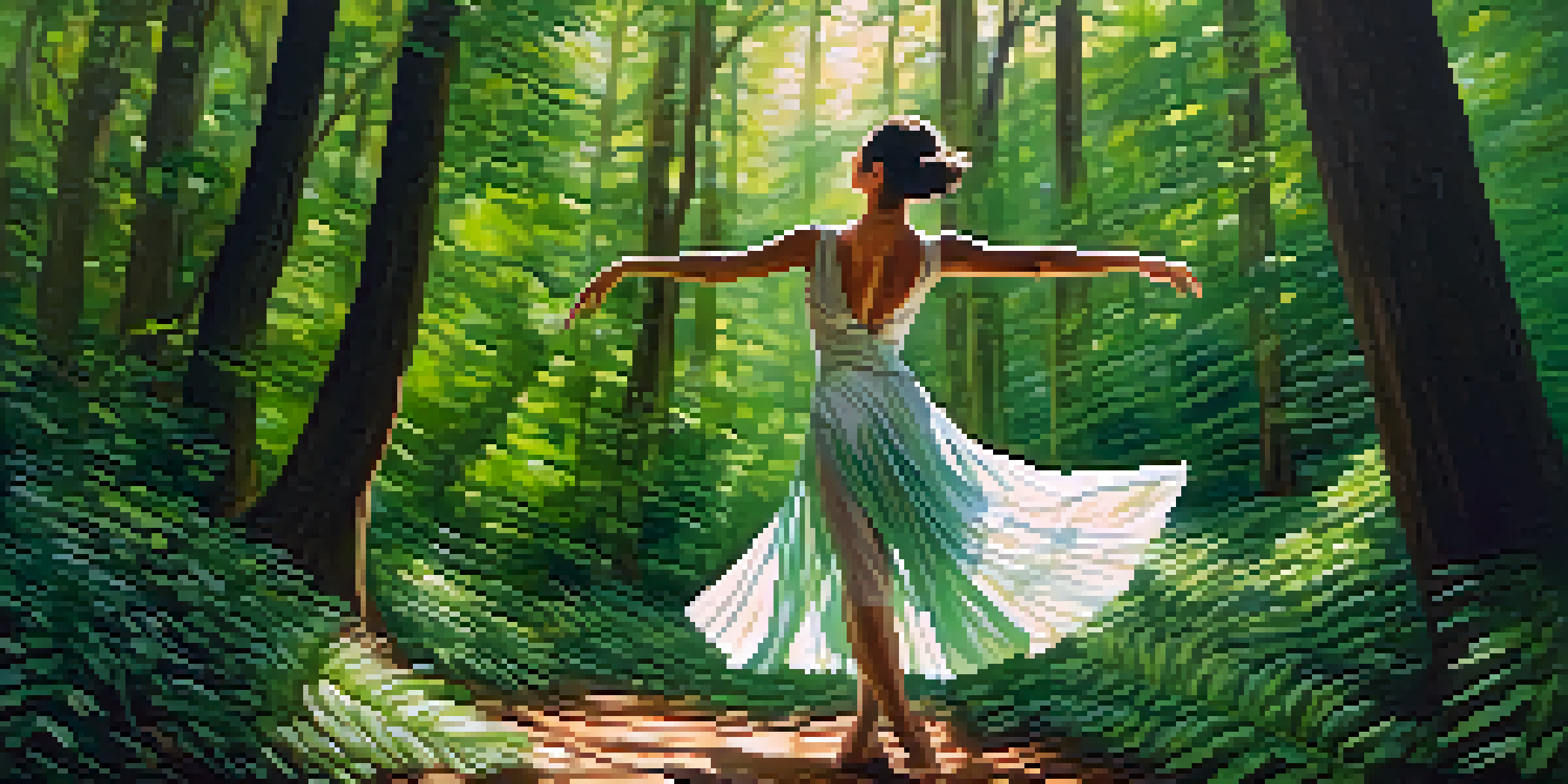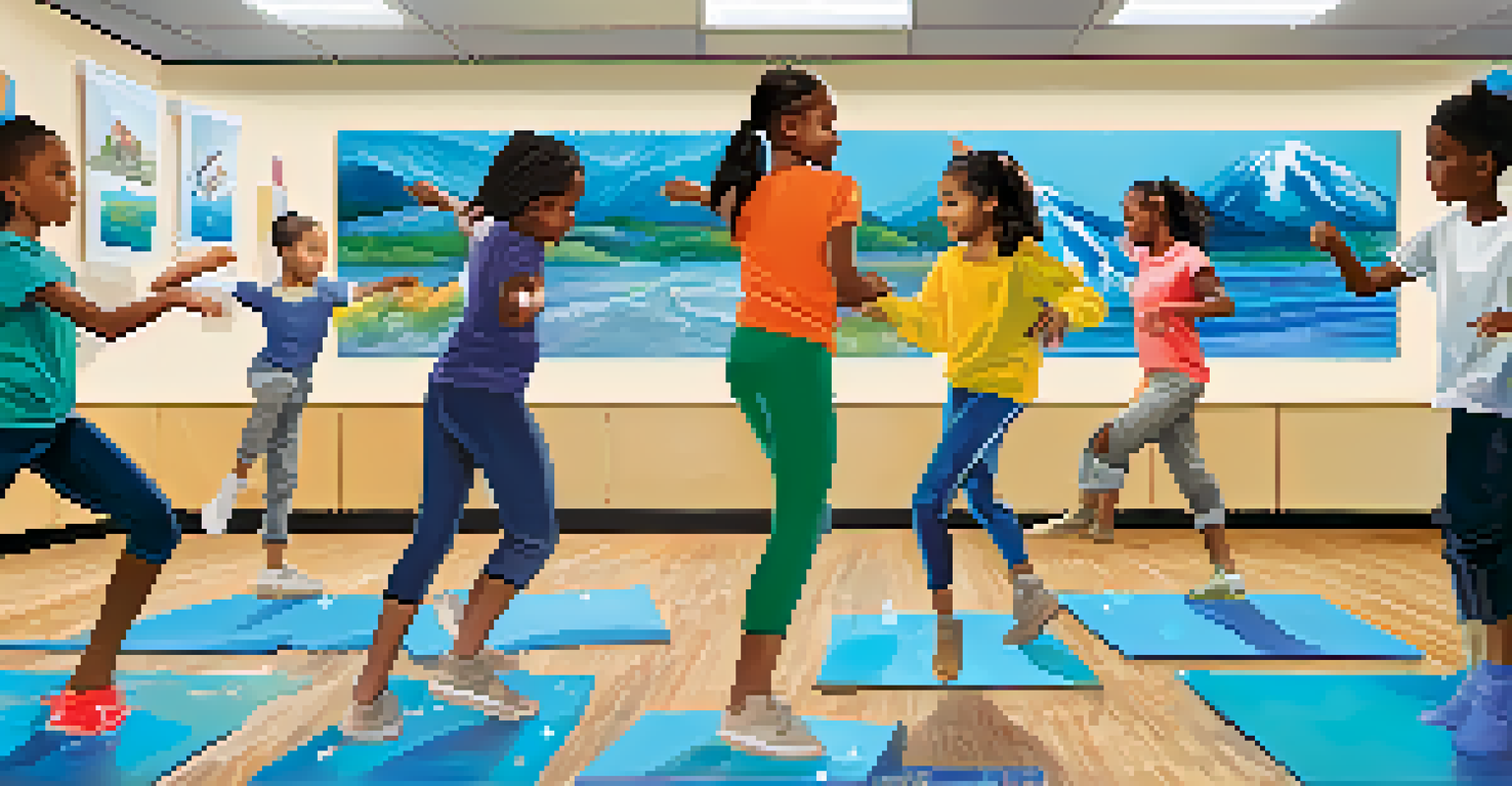The Intersection of Dance and Environmental Education

Understanding the Connection Between Dance and Nature
Dance is often seen as a form of expression, but at its core, it's deeply intertwined with nature. Just as the rhythm of a dance can mirror the changing seasons, the movements can also reflect the beauty and fragility of our environment. By exploring these connections, dancers can cultivate a greater appreciation for the natural world.
Dance is the hidden language of the soul.
For instance, dancers can draw inspiration from the fluid motions of water or the graceful sway of trees in the wind. This not only enriches their performance but also encourages audiences to see nature in a new light. When dance embodies these elements, it can evoke emotions that resonate with our experiences of the environment.
Ultimately, understanding this connection allows dancers to become advocates for nature. By highlighting environmental themes through movement, they can inspire others to care deeply about the planet and its preservation.
Dance as a Medium for Environmental Advocacy
Dance can serve as a powerful platform for raising awareness about environmental issues. Choreographers often use their art to comment on pressing topics such as climate change, deforestation, and pollution. This form of expression can reach people in ways that statistics and reports often cannot.

For example, a dance performance centered on the plight of endangered species can evoke empathy and prompt action from the audience. The visual and emotional elements of dance can create a lasting impact that encourages individuals to engage with environmental initiatives.
Dance Reflects Nature's Beauty
Dance movements can mirror the elegance and fragility of nature, inspiring both performers and audiences to appreciate the environment.
Moreover, incorporating environmental messages into dance can foster community involvement. Workshops and performances can bring together dancers and environmentalists to collaborate on projects that highlight the urgency of protecting our planet.
Educational Programs that Combine Dance and Environmental Science
Many educational programs are beginning to blend dance with environmental science, creating a unique approach to learning. These initiatives allow students to explore complex ecological concepts through movement, making the information more accessible and engaging. Rather than sitting in a classroom, students can embody the lessons they learn.
The earth has music for those who listen.
For example, a program might involve students creating a dance that illustrates the water cycle. By physically representing the process, they not only grasp the concept better but also develop a personal connection to the environment. This kinesthetic learning approach can be particularly effective in engaging younger audiences.
Furthermore, these programs often encourage collaboration among students, fostering teamwork and creativity. As they work together to create dances that reflect environmental themes, they develop both artistic skills and a sense of responsibility towards the planet.
The Role of Community Dance Projects in Environmental Awareness
Community dance projects can play a pivotal role in promoting environmental awareness. These initiatives often bring together diverse groups of people, allowing them to share their experiences and perspectives on environmental issues. Through collective movement, participants can express their concerns and hopes for the future.
For instance, a community dance project might culminate in a performance that addresses local environmental challenges, such as urban pollution or habitat loss. This can galvanize community members to take action, fostering a sense of ownership over their environment and encouraging collective responsibility.
Dance as Environmental Advocacy
Choreographers use dance to highlight pressing environmental issues, effectively engaging audiences in ways that traditional statistics cannot.
Moreover, these projects can inspire creativity and innovation in problem-solving. Participants might brainstorm ways to address environmental issues through art, leading to new ideas and initiatives that benefit their community.
Case Studies: Successful Initiatives Merging Dance and Environment
Several successful case studies showcase the impact of merging dance with environmental education. For example, the 'Dancing Earth' project focuses on indigenous dance forms to convey environmental messages, highlighting the importance of cultural heritage in conservation efforts. These performances not only educate audiences but also honor the connection between indigenous communities and their environment.
Another noteworthy initiative is the 'Earthdance' festival, which gathers dancers from around the globe to perform in natural settings. This celebration of movement in nature raises awareness about environmental preservation while fostering a global community of artists committed to protecting the planet.
These examples illustrate how dance can serve as a conduit for meaningful conversations about environmental issues, bridging cultural gaps and fostering collaboration among diverse communities.
The Power of Dance in Inspiring Personal Change
Dance has the unique ability to inspire personal transformation, and this extends to how individuals engage with environmental issues. Through movement, people can explore their relationship with nature, leading to greater self-awareness and commitment to sustainable living. The physicality of dance encourages a deeper connection to the body, often sparking introspection about one's impact on the planet.
For instance, a dancer may find that performing a piece about climate change prompts them to reconsider their daily habits, such as reducing waste or conserving energy. This personal shift can ripple outward, influencing friends and family to adopt more environmentally friendly practices.
Education Merges Dance and Science
Educational programs that blend dance with environmental science make complex ecological concepts more accessible and engaging for students.
Additionally, dance can empower individuals to advocate for larger systemic changes. As they develop a deeper understanding of environmental issues through movement, they may feel motivated to participate in activism, community programs, or policy changes that promote sustainability.
Future Directions: Expanding the Intersection of Dance and Environmentalism
Looking ahead, the intersection of dance and environmental education offers exciting possibilities for innovation and collaboration. As more artists and educators recognize the potential for dance to convey complex messages, we can expect to see an increase in interdisciplinary projects that combine movement with environmental science. This evolution could lead to new forms of artistic expression that resonate with diverse audiences.
Moreover, technology is playing a crucial role in this evolution. Virtual reality and digital platforms can enhance dance performances, allowing audiences to experience environmental themes in immersive ways. This could open up new avenues for engagement and education, reaching audiences far beyond traditional settings.

Ultimately, the continued exploration of this intersection can foster a culture of creativity and sustainability. By encouraging dancers, educators, and environmentalists to collaborate, we can cultivate a more profound respect for our planet and inspire actions that benefit both art and the environment.